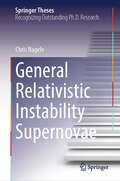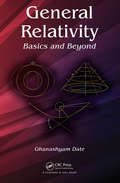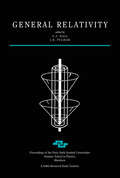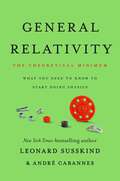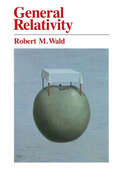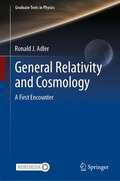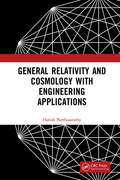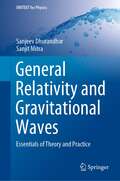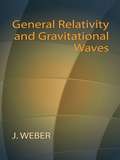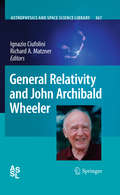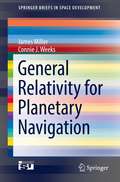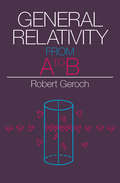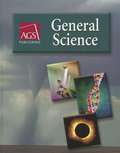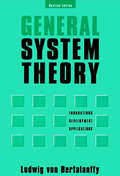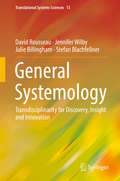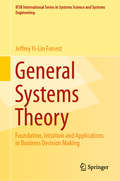- Table View
- List View
General Relativistic Instability Supernovae (Springer Theses)
by Chris NageleThis book provides a comprehensive description of advances in the study of general relativistic instability supernovae. These supernovae, if observed, would provide direct evidence of the existence of supermassive stars, thus confirming that massive seed black holes played a crucial role in the assembly of observed high redshift quasars. The book begins with a review of the history of and motivation for the study of supermassive stars. Supermassive stars are most likely to exist in the high redshift universe and are thus difficult to find. One possibility for observing these stars is the thermonuclear explosion occurring at the end of the lives of some supermassive stars. In order to model these explosions, the author first performs evolutionary simulations with a post Newtonian stellar evolution code HOSHI, evolves these simulations to the general relativistic radial instability, locating the instability using a normal mode analysis of the radial perturbations of the star in general relativity. Next, when the star becomes unstable, the author simulates the dynamics of the explosion or collapse to a black hole by transporting the model to a general relativistic Lagrangian hydrodynamics code with a nuclear network. The two main explosion mechanisms for these stars are the explosive alpha process and the CNO cycle and rapid proton capture process. If the model explodes, the nucleosynthetic ejecta and the light-curve are computed. For multiple types of supermassive stars, it is found that general relativistic instability supernovae are a general consequence of the existence of supermassive stars which are destabilized during their evolution by general relativity. These results run contrary to those of previous papers which found that these types of explosions were much rarer. The results are compared to existing James Webb Space Telescope data and prospects for observation using future instruments are discussed. The book is intended for physics and astronomy researchers interested in the origin and growth of massive black holes, the evolution and explosions of massive stars, and supernovae and chemical enrichment of the early universe.
General Relativity: Basics and Beyond
by Ghanashyam DateA Broad Perspective on the Theory of General Relativity and Its Observable ImplicationsGeneral Relativity: Basics and Beyond familiarizes students and beginning researchers with the basic features of the theory of general relativity as well as some of its more advanced aspects. Employing the pedagogical style of a textbook, it includes essential id
General Relativity: Proceedings of the Forty Sixth Scottish Universities Summer School in Physics, Aberdeen, July 1995 (Scottish Universities Summer School In Physics Ser. #Vol. 46)
by G. S. Hall J. R. Pulham P. OsborneGeneral Relativity provides an unusually broad survey of the current state of this field. Chapters on mathematical relativity cover many topics, including initial value problems, a new approach to the partial differential equations of physics, and work on exact solutions. The chapters on relativistic cosmology and black holes explore cosmology. Other chapters deal with gravitational waves, experimental relativity, quantum gravity, and aspects of computing in relativity. The book will be useful both to postgraduates and to established workers in the field.
General Relativity
by M. P. Hobson G. P. Efstathiou A. N. LasenbyAfter reviewing the basic concept of general relativity, this introduction discusses its mathematical background, including the necessary tools of tensor calculus and differential geometry. These tools are used to develop the topic of special relativity and to discuss electromagnetism in Minkowski spacetime. Gravitation as spacetime curvature is introduced and the field equations of general relativity derived. After applying the theory to a wide range of physical situations, the book concludes with a brief discussion of classical field theory and the derivation of general relativity from a variational principle.
General Relativity: The Theoretical Minimum (The Theoretical Minimum)
by Leonard Susskind André CabannesThe latest volume in the New York Times–bestselling physics series explains Einstein&’s masterpiece: the general theory of relativity He taught us classical mechanics, quantum mechanics, and special relativity. Now, physicist Leonard Susskind, assisted by a new collaborator, André Cabannes, returns to tackle Einstein&’s general theory of relativity. Starting from the equivalence principle and covering the necessary mathematics of Riemannian spaces and tensor calculus, Susskind and Cabannes explain the link between gravity and geometry. They delve into black holes, establish Einstein field equations, and solve them to describe gravity waves. The authors provide vivid explanations that, to borrow a phrase from Einstein himself, are as simple as possible (but no simpler). An approachable yet rigorous introduction to one of the most important topics in physics, General Relativity is a must-read for anyone who wants a deeper knowledge of the universe&’s real structure.
General Relativity: Structured Paternalism and The Landscape of Choice
by Robert M. Wald"Wald's book is clearly the first textbook on general relativity with a totally modern point of view; and it succeeds very well where others are only partially successful. The book includes full discussions of many problems of current interest which are not treated in any extant book, and all these matters are considered with perception and understanding."—S. Chandrasekhar "A tour de force: lucid, straightforward, mathematically rigorous, exacting in the analysis of the theory in its physical aspect."—L. P. Hughston, Times Higher Education Supplement "Truly excellent. . . . A sophisticated text of manageable size that will probably be read by every student of relativity, astrophysics, and field theory for years to come."—James W. York, Physics Today
General Relativity and Cosmology: A First Encounter (Graduate Texts in Physics)
by Ronald J. AdlerGravitational physics has now become a mainstream topic in physics and physics teaching. In particular cosmology and gravitational wave physics are at the focus of a great deal of current research. Thus it is important to introduce students to General Relativity as soon as reasonable. This textbook offers a brief but comprehensive treatment accessible to advanced undergraduate students, graduate students, and any physicist or mathematician interested in understanding the material in a short time. The author, an experienced teacher of the subject, has included numerous examples and exercises to help students consolidate the ideas they have learned.
General Relativity and Cosmology with Engineering Applications
by Harish ParthasarathyThis is a reference book for researchers working in the field of general relativity, quantum mechanics andquantum gravity. A major part of the book deals with the formulation of special relativistic mechanics, special relativistic fluid dynamics and its generalization to general relativity where the gravitational field is described by a metric tensor. Emphasis is laid on the fact that the general theory of relativity is of tensorial character under all dieomorphisms of space-time and hence its field equations, namely the Einstein field equations for gravitation, the Maxwell equations in a curved space-time geometry and the fluid dynamical equations in curved space time are all valid for all observers in the universe. The emphasis throughout is on the fact that matter generates a gravitational field described by a metric that has a non-vanishing curvature tensor and hence such space-times are inherently curved, ie, cannot be transformed into Minkowsian form. There is a final section on quantum mechanics and quantum field theory which introduces supersymmetry and quantum gravity to the reader. The reader after going through this book will be sufficiently well equipped to start research in quantum gravity, i.e, background independent physics which is as yet an unsolved problem owing to renormalization problems.Note: T& F does not sell or distribute the Hardback in India, Pakistan, Nepal, Bhutan, Bangladesh and Sri Lanka.
General Relativity and Gravitation
by Abhay Ashtekar Beverly K. Berger James Isenberg Malcolm MaccallumExplore spectacular advances in cosmology, relativistic astrophysics, gravitational wave science, mathematics, computational science, and the interface of gravitation and quantum physics with this unique celebration of the centennial of Einstein's discovery of general relativity. Twelve comprehensive and in-depth reviews, written by a team of world-leading international experts, together present an up-to-date overview of key topics at the frontiers of these areas, with particular emphasis on the significant developments of the last three decades. Interconnections with other fields of research are also highlighted, making this an invaluable resource for both new and experienced researchers. Commissioned by the International Society on General Relativity and Gravitation, and including accessible introductions to cutting-edge topics, ample references to original research papers, and informative colour figures, this is a definitive reference for researchers and graduate students in cosmology, relativity, and gravitational science.
General Relativity and Gravitational Waves: Essentials of Theory and Practice (UNITEXT for Physics)
by Sanjeev Dhurandhar Sanjit MitraThis book serves as a textbook for senior undergraduate students who are learning the subject of general relativity and gravitational waves for the first time. Both authors have been teaching the course in various forms for a few decades and have designed the book as a one stop book at basic level including derivations and exercises. A spectacular prediction of general relativity is gravitational waves. Gravitational waves were first detected by the LIGO detectors in 2015, hundred years after their prediction. Both authors are part of the LIGO Science Collaboration and were authors on the discovery paper. Therefore, a strong motivation for this book is to provide the essential concepts of general relativity theory and gravitational waves with their modern applications to students and to researchers who are new to the multi-disciplinary field of gravitational wave astronomy. One of the advanced topics covered in this book is the fundamentals of gravitational wave data analysis, filling a gap in textbooks on general relativity. The topic blends smoothly with other chapters in the book not only because of the common area of research, but it uses similar differential geometric and algebraic tools that are used in general relativity.
General Relativity and Gravitational Waves
by J. WeberAn internationally famous physicist and electrical engineer, the author of this text was a pioneer in the investigation of gravitational waves. Joseph Weber's General Relativity and Gravitational Waves offers a classic treatment of the subject. Appropriate for upper-level undergraduates and graduate students, this text remains ever relevant. Brief but thorough in its introduction to the foundations of general relativity, it also examines the elements of Riemannian geometry and tensor calculus applicable to this field.Approximately a quarter of the contents explores theoretical and experimental aspects of gravitational radiation. The final chapter focuses on selected topics related to general relativity, including the equations of motion, unified field theories, Friedman's solution of the cosmological problem, and the Hamiltonian formulation of general relativity. Exercises. Index.
General Relativity and its Applications: Black Holes, Compact Stars and Gravitational Waves
by Paolo Pani Valeria Ferrari Leonardo GualtieriContaining the latest, groundbreaking discoveries in the field, this text outlines the basics of Einstein’s theory of gravity with a focus on its most important astrophysical consequences, including stellar structures, black holes and the physics of gravitational waves. Blending advanced topics - usually not found in introductory textbooks - with examples, pedagogical boxes, mathematical tools and practical applications of the theory, this textbook maximises learning opportunities and is ideal for master and graduate students in Physics and Astronomy. Key features:• Provides a self-contained and consistent treatment of the subject that does not require advanced previous knowledge of the field.• Explores the subject with a new focus on gravitational waves and astrophysical relativity, unlike current introductory textbooks.• Fully up-to-date, containing the latest developments and discoveries in the field.
General Relativity and John Archibald Wheeler
by Ignazio Ciufolini Richard A. MatznerObservational and experimental data pertaining to gravity and cosmology are changing our view of the Universe. General relativity is a fundamental key for the understanding of these observations and its theory is undergoing a continuing enhancement of its intersection with observational and experimental data. These data include direct observations and experiments carried out in our solar system, among which there are direct gravitational wave astronomy, frame dragging and tests of gravitational theories from solar system and spacecraft observations. This book explores John Archibald Wheeler's seminal and enduring contributions in relativistic astrophysics and includes: the General Theory of Relativity and Wheeler's influence; recent developments in the confrontation of relativity with experiments; the theory describing gravitational radiation, and its detection in Earth-based and space-based interferometer detectors as well as in Earth-based bar detectors; the mathematical description of the initial value problem in relativity and applications to modeling gravitational wave sources via computational relativity; the phenomenon of frame dragging and its measurement by satellite observations. All of these areas were of direct interest to Professor John A. Wheeler and were seminally influenced by his ideas.
General Relativity for Planetary Navigation (SpringerBriefs in Space Development)
by James Miller Connie J. WeeksThis brief approaches General Relativity from a planetary navigation perspective, delving into the unconventional mathematical methods required to produce computer software for space missions. It provides a derivation of the Einstein field equations and describes experiments performed on the Near Earth Asteroid Rendezvous mission, spanning General Relativity Theory from the fundamental assumptions to experimental verification.The software used for planetary missions is derived from mathematics that use matrix notation. An alternative is to use Einstein summation notation, which enables the mathematics to be presented in a compact form but makes the geometry difficult to understand. In this book, the relationship of matrix notation to summation notation is shown. The purpose is to enable the reader to derive the mathematics used in the software in either matrix notation or summation notation. This brief is a useful tool for advanced students and young professionals embarking on careers in planetary navigation.
General Relativity from A to B
by Robert Geroch"This beautiful little book is certainly suitable for anyone who has had an introductory course in physics and even for some who have not."—Joshua N. Goldberg, Physics Today "An imaginative and convincing new presentation of Einstein's theory of general relativity. . . . The treatment is masterful, continual emphasis being placed on careful discussion and motivation, with the aim of showing how physicists think and develop their ideas."—Choice
General Relativity Without Calculus
by Jose Natario"General Relativity Without Calculus" offers a compact but mathematically correct introduction to the general theory of relativity, assuming only a basic knowledge of high school mathematics and physics. Targeted at first year undergraduates (and advanced high school students) who wish to learn Einstein's theory beyond popular science accounts, it covers the basics of special relativity, Minkowski space-time, non-Euclidean geometry, Newtonian gravity, the Schwarzschild solution, black holes and cosmology. The quick-paced style is balanced by over 75 exercises (including full solutions), allowing readers to test and consolidate their understanding.
General Science
by Robert H. Marshall Donald H. Jacobs Allen B. Rosskopf Charles J. LarueThis easy-to-read, richly illustrated textbook, especially useful for students who require extra attention or need additional assistance, offers a comprehensive, systematic overview of key scientific concepts. Fundamental concepts are presented in easily manageable segments.
General Science (2nd Edition)
by Lucy Jane BledsoeThis textbook contains unit lessons on What is Science?, Life Science, Physical Science and Earth Science.
General Science -Civil service- Competitive Exam
by Indic TrustThis is a compilation of questions answer of General Science For Civil Services Competitive Examinations.
General Science class 6 - Andhra Pradesh Board
by State Council of Educational Research and Training Andhra PradeshThis book has 12 chapters. Pupils will be able to focus on Activities, Do you know,Think and discuss,keywords and improve your learning. Teachers give projects to students for improving knowledge.
General Science (Semester 1 and 2) class 7 - Andhra Pradesh Board: జనరల్ సైన్స్ (సెమిస్టర్ 1 మరియు 2) క్లాస్ 7 - ఆంధ్రప్రదేశ్ బోర్డ్
by State Council of Educational Research and Training Andhra Pradeshఈ పుస్తకం లో 2 సెమిస్టర్లు కలవు. ఒక్కో సెమిస్టరు లో 6 యూనిట్లు వున్నాయి. పిల్లలు నేర్చుకోవాల్సిన ముక్యమైన అంశాలు కీలక పదాలు,అభ్యసనను మెరుగు పరుచుకుందాం, ప్రశ్నలకు జవాబులు రాయడం, కృత్యాలు మరియు ప్రాజెక్టు పనులు.
General Science (Semester 1 and 2) class 7 - Andhra Pradesh Board
by State Council of Educational Research and Training Andhra PradeshThis book has 2 semesters. Each semester have 6 chapters. Pupels will be able to understand the concepts of Keywords, improve your learning, Activities and projectworks.
General System Theory: Foundations, Development, Applications
by Ludwig Von BertalanffyGathered here are Ludwig von Bertalanffy's writings on general systems theory, selected and edited to show the evolution of systems theory and to present it applications to problem solving. An attempt to formulate common laws that apply to virtually every scientific field, this conceptual approach has had a profound impact on such widely diverse disciplines as biology, economics, psychology, and demography.
General Systemology: Transdisciplinarity For Discovery, Insight, And Innovation (Translational Systems Sciences #13)
by Stefan Blachfellner Julie Billingham Jennifer Wilby David RousseauThis book expands the foundations of general systems theory to enable progress beyond the rich heuristic practices available today. It establishes a foundational framework for the development of scientific transdisciplinary systems principles and shows how these can amplify the potential of individuals and teams working in multi-, inter- and transdisciplinary contexts or striving to translate their progress across disciplinary boundaries. Three general scientific systems principles are presented, and their relevance to the design, analysis, management and transformation of systems is explored. Applying lessons from the history and philosophy science, this book disambiguates key concepts of general systemology, clarifies the role of general systemology within the field of systemology, and explains how general systemology supports other forms of transdisciplinarity. These insights are used to develop new perspectives, strategies and tools for addressing long-standing challenges to the advancement and transdisciplinary application of general insights into the nature of complex systems.The material presented in this book includes comprehensive models of the structure of systemology as a disciplinary field, the structure and significance of the general systems worldview, and the role of general systemology as the heart of systems science, systems engineering and systems practice. It explains what a fully-fledged general theory of systems would look like, what its potential is, what routes are available to us to develop it further, and how to leverage the knowledge we have attained so far. Many examples and analogies show how general systemology has the potential to enable scientific discovery, insightful theory building, and practical innovation in all the disciplines as they study, design, nurture or transform complex systems. This book is essential reading for anyone wishing to master the concepts, terminology, models and strategies needed to make effective use of current general systems knowledge and to engage in the further development of the philosophy, science, and practice of general systemology.
General Systems Theory: Foundation, Intuition And Applications In Business Decision Making (Ifsr International Series In Systems Science And Systems Engineering Ser. #32)
by Jeffrey Yi-Lin ForrestThis book demonstrates the theoretical value and practical significance of systems science and its logic of thinking by presenting a rigorously developed foundation—a tool for intuitive reasoning, which is supported by both theory and empirical evidence, as well as practical applications in business decision making. Following a foundation of general systems theory, the book presents an applied method to intuitively learn system-sciences fundamentals. The third and final part examines applications of the yoyo model and the theoretical results developed earlier within the context of problems facing business decision makers by organically combining methods of traditional science, the first dimension of science, with those of systems science, the second dimension, as argued by George Klir in the 1990s. This text would benefit graduate students, researchers, or practitioners in the areas of mathematics, systems science or engineering, economics, and business decision science.
